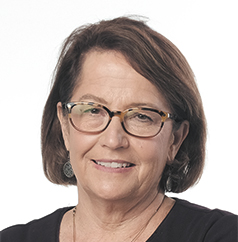Subscriber Benefit
As a subscriber you can listen to articles at work, in the car, or while you work out. Subscribe NowThe Indiana Supreme Court’s 2022-2023 Annual Report has been released, highlighting several new developments for the court over the last year, including the addition of Justice Derek Molter and the rule change allowing cameras in courtrooms.
Chief Justice Loretta Rush sat with members of the media on Thursday afternoon to discuss the report and provide updates on projects the high court is working on.
Rush started by pointing out the table everyone was sitting at, which was crafted by Indiana Department of Correction inmates. She said she went to the Pendleton Correctional Facility and met the inmates who created the table.
“It’s just something beautiful, those lives that are in there and have this talent,” she said.
Turning to the meat of the report, Rush highlighted last year’s Mental Health Summit, which she said left county officials feeling “energized” about the various ways they can respond to mental illness in the criminal justice system.
“We have too many people that are just arrested and come to court and arrested and then come to court, go to jail, arrested. It’s not the best thing for them,” Rush said. “And it’s taking up jail space, it’s making them worse. So the more we can work within our communities on the diversion, it’s better.”
She added that the 988 suicide and crisis lifeline is working well, and that permanent funding would benefit it.
Turning to cameras in court, Rush said while judges retain discretion on whether to allow broadcasting from their courtrooms, the amendment to Rule 2.17 was a long time coming and is an important tool to allow the public to see how the judiciary works.
“I think we all in all three branches of government need to do more with regard to transparency just get our story out,” she said.
Rush added that she is pushing trial court judges to put their calendars online. Some courts have already done so, she said, but others are reluctant.
Turning to the judicial work of the Supreme Court, the annual report notes that 58 total opinions were issued during the 2022-2023 fiscal year, compared to 81 the previous year. Rush said the decrease could be caused by a number of factors.
“It could be the turnover in the court, it could be the type of cases,” she said, referencing the retirement of Justice Steven David and the addition of Molter. “We have a really strong Court of Appeals that has been writing some solid cases, with a lot of longevity in the Court of Appeals, so I think there’s a lot of factors.”
In the world of court technology, the report notes that in 2022, Marion, Monroe and Vigo counties began piloting the use of text message reminders in certain family cases, like juvenile paternity and divorce with and without children. The result, Rush said, is that people are showing up to court at higher rates than without the text message reminders.
Another court tech project, INjail, is still in its infancy with plenty of kinks to work out, Rush said. Besides the Odyssey case management system, the creation of INjail is the biggest project the court has undertaken.
INjail is being designed to interface with other criminal justice applications, like the state’s case management system and the Indiana State Police criminal history database. Martin County has begun piloting the system, and Grant and Elkhart counties are planned to follow.
Rush said it will take a while to get INjail up and running, but it will be great once it is done.
Turning to legal education, Rush said a concern of hers is the state’s bar passage rate.
The 2020-2021 pass rate was 72%, a spike likely attributed to accommodations made for COVID, but the number has been going down since, hitting 65% in 2021-2022 and 63% in 2022-2023.
Relatedly, Indiana’s attorney shortage is still a problem. Rush said the court is looking at how other states address that issue, and at the use of limited license attorneys and paralegals.
“Losing Valparaiso was devastating to our profession,” Rush said of the 2020 closure of Valparaiso Law. “A lot of our prosecutors, public managers, child welfare attorneys, some of our public servants came from there.”
Please enable JavaScript to view this content.

